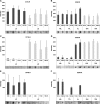Proteomics of Thlaspi caerulescens accessions and an inter-accession cross segregating for zinc accumulation
- PMID: 20048332
- PMCID: PMC2826651
- DOI: 10.1093/jxb/erp372
Proteomics of Thlaspi caerulescens accessions and an inter-accession cross segregating for zinc accumulation
Abstract
Metal hyperaccumulator plants have previously been characterized by transcriptomics, but reports on other profiling techniques are scarce. Protein profiles of Thlaspi caerulescens accessions La Calamine (LC) and Lellingen (LE) and lines derived from an LCxLE cross were examined here to determine the co-segregation of protein expression with the level of zinc (Zn) hyperaccumulation. Although hydrophobic proteins such as membrane transporters are not disclosed, this approach has the potential to reveal other proteins important for the Zn hyperaccumulation trait. Plants were exposed to metals. Proteins were separated using two-dimensional electrophoresis and those showing differences among accessions, lines or metal exposures were subjected to mass-spectrometric analysis for identification. Crossing decreased the number of different proteins in the lines compared with the parents, more so in the shoots than in the roots, but the frequencies of Zn-responsive proteins were about the same in the accessions and the selection lines. This supports the finding that the Zn accumulation traits are mainly determined by the root and that Zn accumulation itself is not the reason for the co-segregation. This study demonstrates that crossing accessions with contrasting Zn accumulation traits is a potent tool to investigate the mechanisms behind metal hyperaccumulation. Four tentatively identified root proteins showed co-segregation with high or low Zn accumulation: manganese superoxide dismutase, glutathione S-transferase, S-formyl glutathione hydrolase, and translation elongation factor 5A-2. However, these proteins may not be the direct determinants of Zn accumulation. The role of these and other tentatively identified proteins in Zn accumulation and tolerance is discussed.
Figures


Similar articles
-
Metallothioneins 2 and 3 contribute to the metal-adapted phenotype but are not directly linked to Zn accumulation in the metal hyperaccumulator, Thlaspi caerulescens.J Exp Bot. 2009;60(1):187-96. doi: 10.1093/jxb/ern287. Epub 2008 Nov 25. J Exp Bot. 2009. PMID: 19033549 Free PMC article.
-
Construction of a genetic linkage map of Thlaspi caerulescens and quantitative trait loci analysis of zinc accumulation.New Phytol. 2006;170(1):21-32. doi: 10.1111/j.1469-8137.2005.01631.x. New Phytol. 2006. PMID: 16539600
-
Multivariate analysis of protein profiles of metal hyperaccumulator Thlaspi caerulescens accessions.Proteomics. 2006 Jun;6(12):3696-706. doi: 10.1002/pmic.200501357. Proteomics. 2006. PMID: 16691554
-
Investigating heavy-metal hyperaccumulation using Thlaspi caerulescens as a model system.Ann Bot. 2008 Jul;102(1):3-13. doi: 10.1093/aob/mcn063. Epub 2008 Apr 25. Ann Bot. 2008. PMID: 18440996 Free PMC article. Review.
-
[Heavy metal absorption, transportation and accumulation mechanisms in hyperaccumulator Thlaspi caerulescens].Sheng Wu Gong Cheng Xue Bao. 2010 May;26(5):561-8. Sheng Wu Gong Cheng Xue Bao. 2010. PMID: 20684297 Review. Chinese.
Cited by
-
AtCRY2 Negatively Regulates the Functions of AtANN2 and AtANN3 in Drought Tolerance by Affecting Their Subcellular Localization and Transmembrane Ca2+ Flow.Front Plant Sci. 2021 Nov 23;12:754567. doi: 10.3389/fpls.2021.754567. eCollection 2021. Front Plant Sci. 2021. PMID: 34887887 Free PMC article.
-
Characterization of the glyoxalase 1 gene TcGLX1 in the metal hyperaccumulator plant Thlaspi caerulescens.Planta. 2011 Jun;233(6):1173-84. doi: 10.1007/s00425-011-1370-7. Epub 2011 Feb 15. Planta. 2011. PMID: 21327818
-
HMA4 expression in tobacco reduces Cd accumulation due to the induction of the apoplastic barrier.J Exp Bot. 2014 Mar;65(4):1125-39. doi: 10.1093/jxb/ert471. Epub 2014 Jan 13. J Exp Bot. 2014. PMID: 24420575 Free PMC article.
-
Genome Structure of the Heavy Metal Hyperaccumulator Noccaea caerulescens and Its Stability on Metalliferous and Nonmetalliferous Soils.Plant Physiol. 2015 Sep;169(1):674-89. doi: 10.1104/pp.15.00619. Epub 2015 Jul 20. Plant Physiol. 2015. PMID: 26195571 Free PMC article.
-
Recent advances in the analysis of metal hyperaccumulation and hypertolerance in plants using proteomics.Front Plant Sci. 2013 Jul 26;4:280. doi: 10.3389/fpls.2013.00280. eCollection 2013. Front Plant Sci. 2013. PMID: 23898342 Free PMC article.
References
-
- Ahsan N, Lee D-G, Alam I, et al. Comparative proteomic study of arsenic-induced differentially expressed proteins in rice roots reveals glutathione plays a central role during As stress. Proteomics. 2008;8:3561–3576. - PubMed
-
- Assunção AGL, Pieper B, Vromans J, Lindhout P, Aarts MGM, Schat H. Construction of a genetic linkage map of Thlaspi caerulescens and quantitative trait loci analysis of zinc accumulation. New Phytologist. 2006;170:21–32. - PubMed
-
- Assunção AGL, Ten Bookum WM, Nelissen HJM, Vooijs R, Schat H, Ernst WHO. Differential metal-specific tolerance and accumulation patterns among Thlaspi caerulescens populations originating from different soil types. New Phytologist. 2003a;159:411–419. - PubMed
-
- Assunção AGL, Ten Bookum WM, Nelissen HJM, Vooijs R, Schat H, Ernst WHO. A cosegregation analysis of zinc (Zn) accumulation and Zn tolerance in the Zn hyperaccumulator Thlaspi caerulescens. New Phytologist. 2003b;159:383–390. - PubMed

